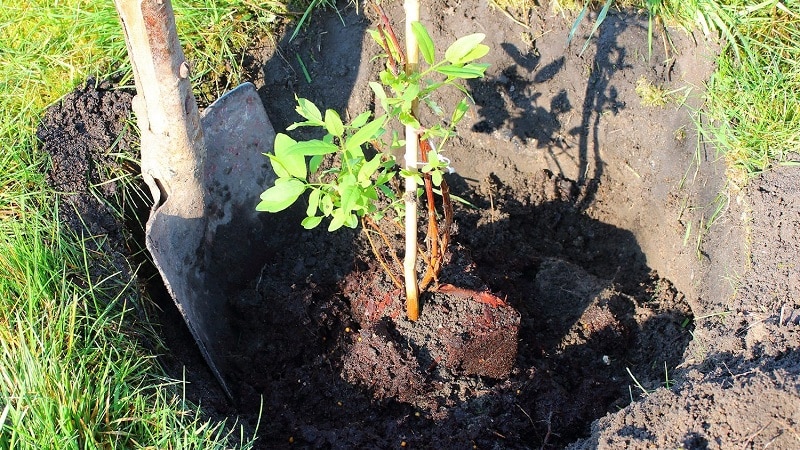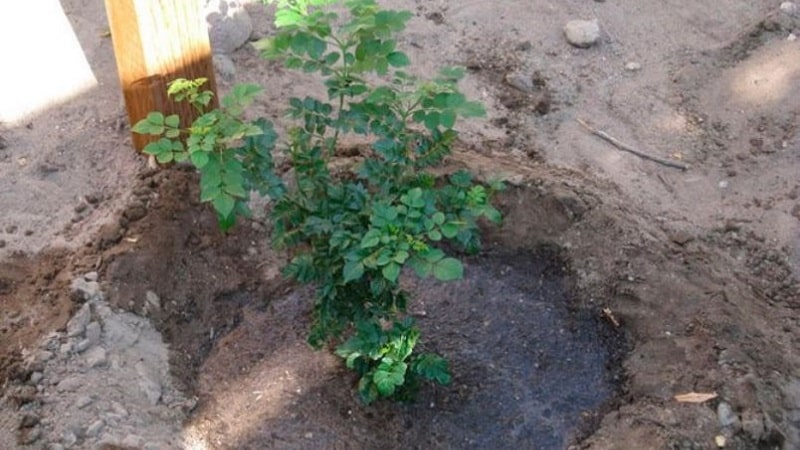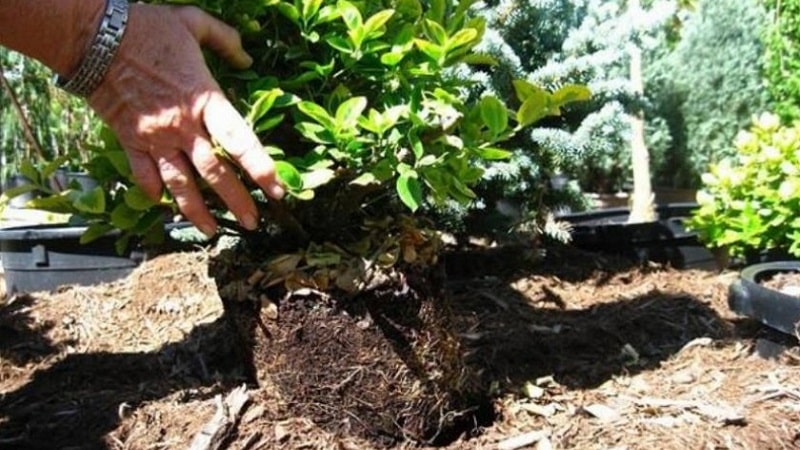Planting and caring for honeysuckle in the open ground in spring
plant honeysuckle Even a novice gardener will be able to go into open ground in the spring if he selects the right seedlings, a place for plants and prepares planting holes. From the article you will learn how to care for honeysuckle so that there is a good harvest.
When is it better to plant honeysuckle - in spring or autumn?
Both seasons are suitable for the procedure, but each has its nuances. Among the advantages autumn landing highlight the following:
- the culture takes root better;
- the plant has time to grow its root system and take root;
- The bush hardens and its endurance increases.

If you plant in the spring, you will have the opportunity to observe the development of seedlings. And if the slightest problems appear, they can be eliminated by applying fertilizers, adjusting the watering regime and treating them against pests. But there is a risk of not meeting the deadlines and harming the plants.
Planting honeysuckle in open ground in spring
Before you start working, you need to choose the right planting material and decide on its placement scheme so that the bushes do not interfere with each other.
It is advisable to do this in early spring, while the crop is still dormant.. As soon as the snow melts, it's time to start planting honeysuckle. Young shrubs are planted before buds open. If the plant enters the vegetative stage, it will have difficulty establishing roots.
Selection of seedlings
Healthy planting material is selected in accordance with certain criteria:
- age – from 2 years, height – 0.5-1 m, number of shoots – 2-3;
- roots are moist and well developed;
- branches are flexible, with fruit buds, without foliage;
- all parts of the seedling are clean, without signs of disease or pest damage.
It is advisable to take young shoots in containers so that the root system is protected earthen coma. This will help the crop quickly adapt to the planting site.
Important! Honeysuckle is a cross-pollinated shrub. You need to buy 3-4 seedlings of different varieties with the same flowering time to guarantee fruiting.
Step-by-step planting instructions
For culture, it is better to choose a slightly shaded place with diffused lighting. The best option is near the trees.
When planting, maintain a distance of 1.5-2 m between bushes and 2-3 m between rows. Mature plants grow in width and take up a lot of space, so they cannot be placed close to each other. Next, everything depends on the type of root system - for each of them the instructions will be different.
With open root system
Procedure:
- Remove the top layer of soil, mix it with humus in equal proportions.
- Dig a planting hole 3-6 cm deep than the root ball of soil.
- Lay drainage from gravel or broken bricks.
- Form a small mound of soil mixture on top. Place the seedling inside it.
- Distribute the roots over the entire area of the hole. Sprinkle with soil.
- Water the plant and lightly compact the soil.

With closed root system
How to plant a seedling:
- Dig holes. Spread a mixture of peat soil and vermicompost on the bottom in a 1:1 ratio.
- Remove the seedling from the container. Lightly ruffle the earthen ball to distribute the roots evenly throughout the hole.
- Moisten the hole well.
- Place the seedling inside, straighten the roots and sprinkle with soil.
- Mulch the soil around the plant with sawdust or hay.
Honeysuckle with a closed root system can be planted at any time of the year.. With proper care, the plant will successfully take root in its new location.
Landing Features
The shrub easily adapts to low temperatures. But the climatic conditions of Siberia and Ural too harsh for him. Therefore, scientists have developed hybrids that are adapted not only to winter cold, but also to frost during flowering.
They have an early flowering period and increased disease resistance. Regular varieties of honeysuckle are not suitable for this area. But the planting technology in northern latitudes is slightly different.
In Siberia
Healthy seedlings 3 years old are selected for planting.. They can withstand harsh winters more easily and take root faster.
Planting holes are dug in advance - in the spring, so that the earth has time to warm up and settle. It is advisable to plant young plants in the fall - 3-4 weeks before the first frost.
In the Urals
The optimal period for planting in the ground depends on the type of root system. If it is open, this is done in May - June. Young bushes with closed roots are planted a month before the onset of winter. The varieties chosen are winter-hardy and early ripening.

Spring care for honeysuckle
First, thin out the crown, if this was not possible in the fall. As the snow melts, nitrogen fertilizers are applied to the root zone. Then they will be absorbed into the soil along with melt water.
At the time of flowering and formation of ovaries, weeding and loosening are required.. If the spring is dry, the bushes need watering at the rate of 30-50 liters per m². If there is a lack of water, the fruits become smaller and lose their juiciness.
Caring for young plants
Seedlings require regular irrigation – at least once a week. At the same time, weather conditions are taken into account: after rain, watering is not needed, and in windy weather, moisture evaporates faster.
The soil is mulched and loosened to retain moisture. Weeds are removed as they appear.
Treatment against diseases and pests
In case of threat of invasion pests or infection plants are treated insecticides or use folk remedies. This must be done before flowering begins, when the temperature rises to +5°C.
For preventative purposes, bushes are regularly inspected and thinned. Dry and damaged leaves and shoots are removed.
Feeding after winter
If the plants are planted in fertile soil, they are not fertilized for the first 2-3 years. Further feeding is needed every year to replenish the supply of nutrients. Used as fertilizers:
- nitrogen, phosphorus and potassium in equal parts;
- fishmeal;
- wood ash.
Fertilizers are applied to the root zone, trying not to get on the leaves and in the center of the bush. To ensure that the nutritional components are absorbed faster, the procedure is combined with watering.
Watering
During the first 15 days after planting, a drip irrigation system is preferable., providing uniform and deep soil moisture. At the same time, the top layer of soil is not eroded and excess water is not consumed.
Grown plants in the spring have enough moisture, which enters the soil after rain. once every 1-1.5 weeks.
Attention! Don't water honeysuckle too often. This causes deformation of the root system. The shrub can more easily withstand a lack of moisture than its excess.
Trimming
It is carried out in early spring, before the growing season begins. Features of the procedure:
 On bushes up to 3 years old, only dead shoots are removed. Mature bushes are pruned every year to stimulate fruiting.
On bushes up to 3 years old, only dead shoots are removed. Mature bushes are pruned every year to stimulate fruiting.- You cannot remove more than 25% of the crown at a time. This will lead to a decrease in yield.
- If there are no visible defects, the tops of the branches are not cut off. Most of the fruit buds are formed on them.
- After pruning, 4-6 healthy old shoots and 2-3 young branches are left.
As a result, shading of the central part of the crown is reduced and the quality of berries improves. At the same time, the risk of fungal development is reduced and the growth of new branches is activated.
Tips for planting and caring for honeysuckle in spring
Experienced gardeners It is recommended to adhere to the following rules:
- Place the crop in an area protected from drafts.
- Choose varieties with high yields and winter hardiness.
- During the flowering period, spray honeysuckle with a sugar solution to attract insects for pollination.
- In the fifth year of the bush's life, thin out the branches. This will help avoid thickening of the crown and the spread of diseases.
- During the formation of ovaries, regular weeding of the root zone and additional watering are necessary.
Proper care of the plant makes it hardy and contributes to a good harvest.
Conclusion
Honeysuckle is a long-lived bush. If you create favorable conditions for the plant and give it due attention, it will bear fruit in one place for 20 years or more. To do this, it is enough to study the features of growing the crop and follow the recommendations.